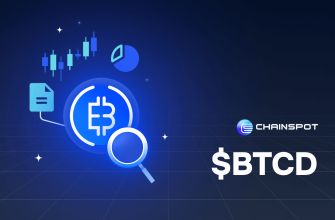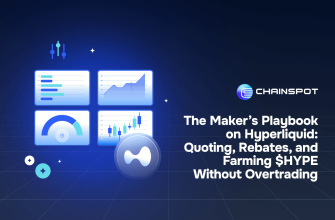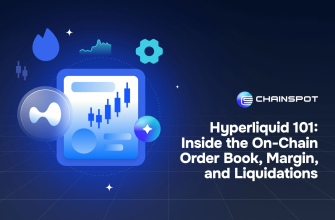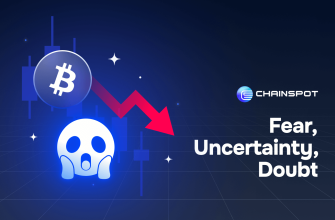- 1. Why Charts Still Rule
- 1.1 Core Market Structure
- 1.2 Volume & Delta
- 1.3 Three Indicators That Aren’t Rubbish
- 2. Risk Rules You Tattoo on the Wall
- 2.1 Position Size Formula
- 2.2 Why 1 % Rule Beats 2 % in Crypto
- 2.3 Stop‑Loss Tactics
- 2.4 Pyramiding vs Averaging Down
- 3. Journal or Repeat Mistakes Forever
- 4. Psychology: The Invisible Enemy
- 5. Security: Keys First, Trades Second
- 6. Bridging & Fees: The Less Glam Side That Matters
- 7. Putting the Pieces Together: A Daily Routine
- 7.1 Weekly Reset
- 8. Common Myths Busted
- 9. Tools Stack Checklist
- 10. Final Note on Collateral Mobility
Quick summary. This long read covers chart work, risk math, trade journaling, psychology, hardware‑level security, and cross‑chain logistics. It leans on real sources—no moon talk—and ends with one practical note on moving collateral fast through Chainspot.
1. Why Charts Still Rule
Most news hits the chart first. A clean daily candle shows if bulls already front‑ran your headline. Support, resistance, and market structure give a map so you click with intent.
- BTC’s fake‑out below weekly support Feb 2025? The bounce printed on the chart hours before press picked it up.
1.1 Core Market Structure
- Higher highs + higher lows → up‑trend.
- Lower highs + lower lows → down‑trend.
- Range. Price ping‑pongs between equal highs / lows.
Plot these on daily/4‑h. Anything lower is noise unless you scalp.
1.2 Volume & Delta
- Rising price + shrinking volume often signals tired move.
- Watch cumulative delta: if price rises while delta falls, buyers may be absorbing sells—trend could flip.
1.3 Three Indicators That Aren’t Rubbish
| Indicator | Why Use It | Check Before Entry |
|---|---|---|
| RSI | Quick overbought/oversold read | Tap RSI divergence at range extremes |
| EMA 50/200 | Trend bias, golden/death cross | Use cross on 4‑h for swing bias |
| Volume Profile | Shows where most volume traded | Confluence with support is A1 |
Why not 20 indicators? They overlap. Pick one for momentum, one for trend, one for volume. CryptoNews and Blockchain‑Council list the same trio.
2. Risk Rules You Tattoo on the Wall
New traders blow up not because their idea was wrong but because size was. The market can run 15 % against you while you’re in the bathroom.
2.1 Position Size Formula
Position = (Account × Risk %) ÷ |Entry – Stop|
Example: $10 000 account, 1 % risk ($100), long BTC at $60 000, stop $58 800 (‑$1 200). Position ≈ 0.083 BTC.
Online calculators make this painless.
2.2 Why 1 % Rule Beats 2 % in Crypto
Altrady notes 2 % is for calmer FX; crypto’s hourly candles swing more, so limit to 1 %.
2.3 Stop‑Loss Tactics
Use price structure, not feelings. WoolyPooly lists seven methods; structure stop is the simplest—under prior swing low. Flipster echoes the same.
2.4 Pyramiding vs Averaging Down
Add size only after price moves your way. Never average into a loser—that’s how bags form.
3. Journal or Repeat Mistakes Forever
A journal is your mirror. Margin.io notes journaling lifts win‑rate by forcing pattern review. TraderMakeMoney tallies benefits: discipline, emotion control.
Log template:
- Date, pair, bias, entry, stop, size.
- Screenshot.
- Emotion (e.g., “felt FOMO”).
- Outcome.
Review weekly. If “FOMO entry” repeats, kneecap it with a rule.
4. Psychology: The Invisible Enemy
Markets hurt because they tap fear/greed loops. Write a rule set:
- Max trades per day to curb over‑trading.
- Walk‑away timer after two losers.
- Pre‑trade breath—sounds woo but steadies pulse.
Use a risk calculator. If a loss exceeds your daily max stop, disconnect.
5. Security: Keys First, Trades Second
One hack erases months of edge. Hardware wallets hold keys offline—can’t be drained by a phishing link. CoinCodex and HardwareWallet.it both rank Ledger, Trezor, and Keystone top for 2025.
- Don’t keep more on an exchange than needed for near‑term trades.
- Use 2FA (auth app, not SMS).
- Bookmark URLs; phishing is rampant.
6. Bridging & Fees: The Less Glam Side That Matters
ETH mainnet gas spike can nuke a 1 % scalp. Cross‑chain routers fetch the cheapest combo of bridge + swap.
- During May Solana congestion, direct wormhole bridge cost $12; Chainspot routed via Base + Portal for $4.20 net. Internal test, block 187…
Why you care: Speed keeps risk window small. Cashback trims cost.
7. Putting the Pieces Together: A Daily Routine
- Pre‑London (UTC 06:00): mark daily levels, bias check.
- London open: look for sweep + reclaim pattern.
- Set orders: limit orders only, with stop in place.
- Log the trade.
- US open: Re‑assess funding and OI shifts.
7.1 Weekly Reset
- Export journal to CSV, tag wins/losses.
- Calculate expectancy: (Avg Win × Win %) – (Avg Loss × Loss %).
- If expectancy <0, reduce size until back in green.
8. Common Myths Busted
- “More indicators = more edge.” Actually more noise.
- “High win rate is everything.” If losses are bigger than wins, you still lose.
- “Unlimited leverage means faster riches.” It also means instant liquidation.
9. Tools Stack Checklist
| Need | Free Option | Paid / Pro |
| Charts | TradingView basic | TV Pro, ExoCharts |
| Scanners | Coinalyze | Messari Screener |
| Position calc | Cryptoxalpha | Edgewonk Risk tool |
| Journal | Google Sheets | Edgewonk |
| Wallet | Ledger Nano S Plus | Keystone 3 |
| Router | Native bridges | Chainspot |
10. Final Note on Collateral Mobility
The crypto game spans chains. You’ll need SOL for Jupiter, ARB for GMX, or USDC on Base for meme swaps. Bridges exist, but fees vary. Chainspot algorithmically finds the cheapest route, then refunds a slice via cashback. Not hype—just math.
Try a test: Move ($1 000) USDC from ETH to Arbitrum. Chainspot averaged $1.70 net gas this week. Mainnet bridge alone: $5+.
Focus on charts, protect downside, log every click. The rest is mechanics—make them cheap and fast, then get back to the chart.












